Indoor and Patio Plants
Compost can also be used to “top up” pots containing Indoor Plants and Patio plants. The usual approach is to remove the top layer of soil from the pot and add about a 1-5cm of compost to the top of the pot. Alternatively when repotting to a larger pot the compost can be added to the bottom of the new pot
Compost uses in the vegetable and flower garden
Compost is an excellent soil improver and can be used to increase the organic matter in the soil. In temperate climates such as the UK organic material may consist of 50% organic matter in tropical and subtropical climates it may only make up 1% of the soil content. In such climates compost or other organic material needs to be added to the soil more frequently than in the UK (annually) as without frosts soil activity continues throughout the year with the result that organic material is used continually.
Mulch
Compost makes an excellent soil improver and will over the years, make the soil easier to work and lead to a better soil structure to the benefit of both plants and those digging.
Compost consist of organic matter laced with the microbes that helped make it, adding compost will not only improve the biological properties of soil but also help provide a good physical soil structure and provide some of the necessary chemical nutrients and improve the moisture retention in sandy soils. It will also, overtime, improve drainage and aeration, of clay soils. The increased organic material in the compost encourages earthworms and other microbes
This being the case it is understandable that the most common use of home-produced compost is surface mulch. This allows the use of unfinished (non-matured) compost avoiding the need to store it through the maturation stage. The compost can be spread over the flower or vegetable bed in the autumn and left for the worms to take it down into the soil. A clear area, free from mulch, of about 2-3", should be left round the plant stems. If unfinished compost in which the decomposition process is not completed is dug into the soil immediately before planting this may result in stress to the plants and a yellowing of the leaves and stalled growth.
Shewell-Cooper in Compost Gardening (David & Charles 1974) recommend the use of compost in no dig, or minimum dig, gardening where it is spread on the ground surface as a mulch about an inch deep and leaving it for the worms to take it into the soil. It can be spread across the vegetable garden, herbaceous border, fruit patch, shrub border, rose bed in fact across the whole garden. This should prevent the growth of annual weeds, and once the perennials have been removed, save much time that would have been spent hoeing.
More modern no-dig gardeners have updated the systems and recommended various options such as using a layer of 5-15cm (2”-6”).
The compost is usually spread on the garden in the spring put it can be done at any time of year. It is suggested that the compost is topped up annually for the next four years by adding about a 1/4inch of compost to replace that carried down into the soil by the worms. After that time, it is only necessary to add more compost when the soil becomes visible through that already spread.
It can be used in a minimum dig seedbed by spreading at a rate of five bucketfuls per square yard and forking it into the top two inches of soil.
As an alternative to a surface mulch it can be spread and then dug in. On sandy soils compost mulch soil improver is spread over the soil to form a one inch layer and then dug into the soil to just over half the length of the blade of a digging spade (6-8 inches) On Clay soils the quantity should be doubled. This will need supplementing with a nitrogen fertiliser.
Vegetable Gardens. A layer of compost can be added to the surface of the soil in the autumn or winter and it wil be carried down by the worms ready for the spring planting. A "dug in" variation of the surface mulch is favoured by many vegetable gardeners when the mulch is spread and then dig it into the soil in the autumn before planting in the spring or early summer. Digging in will bring the nutrients and humus into the root zone of the plants.
The amount of compost to be used will vary, first and foremost depending on how much you have been able to produce, but also on the use of that area of the garden. The general recommendation is a wheelbarrow load spread over five square metres for before planting the greedier plants such as brassicas, potatoes, tomatoes, and black currants. Over wintering brassicas will also benefit from summer mulch. Other, less hungry, fruit can be mulched every four or five years. Parsley will also benefit from compost mulch.
If an open compost heap or bin is used it is common to grow courgettes and swashes directly on the compost heap. This does mean that it cannot be harvested until the autumn but that is no hardship compared with the benefits. It also means that you can grow courgettes, marrows, and squashes in a relatively small garden without making a permanent vegetable plot.
Flower Beds The compost can be applied as a mulch and left on the surface where digging in would damage roots or bulbs. Compost can also be added to the soil before planting and spread round the base of plants but leaving a space round the atual plant
Trees Used as a mulch round established trees compost can provide essentiasl to a soil which otherwise may be neglected. A 5-10cm layer is recommended.
Square Foot Gardeners, Use compost as a soil amendment by adding a handful of compost each time anything is added to the bed and work it into the soil top layers. New seeds can be sown in the newly enriched soil.
Compost Use by Professional Gardeners
Additional uses of home-produced compost by professional and large-scale gardeners
Planting Trees and shrubs Composting is the ideal material to use as backfill when planting trees and shrubs. It offers the necessary support when filling the gaps round the root ball while retaining moisture and nutrients. It can be used on its own or mixed with some of the soil removed when digging the hole.
Nursery Beds Home compost can be mixed with soil to make a growing medium with good water retention properties and organic content suitable for nursey beds.
Lawns
Compost Top Dressing
Top dressing a lawn with compost can improve the soil structure and provide some nutrients. It will also improve drainage and by adding organic matter to the lawn. It can also be used to fill holes and depressions
A top dressing of compost ofa mix of compos, sharp sand and soil is often applied to the lawn in the autumn. However, the value of more frequent but lighter applications of compost as a top dressing is now being recognised. If adopting this routine of treatment, the first treatment is best applied early in spring when the lawn will be receiving less footfall, reducing the likelihood of compost being carried indoors. It and can be repeated every month where the lawn is used regularly. Mature compost should be used and it is best to sieve or break up the compost as smaller particles can drop between the blades of grass and become incorporated into the soil easily. It is best applied it dry.
Mow the lawn's grass to 1 inch tall. That height helps compost reach the soil between grass blades. Rake the lawn with a metal rake to collect dead grass, leaves and other lawn debris
Compost can be used to top dress the lawn in the autumn but it can also be used in the spring to start the season but do it early so that the lawn will be looking good when you want to use it. The use of compost to make liquid feed is given on a separate page Liquid Feed
Leaving cut grass on the lawn
If you have filled your compost heap/bin with as much grass as it can handle and do not want to send grass cuttings to the Council composting site (now that many Councils charge for providing a garden waste collection) you can leave your cut grass on the lawn.
You may need to mow the lawn more frequently than you might have done if you were going to compost the cut grass and should only mow the lawn when the grass is dry
Cut the grass when it is not more than 4” long setting the mowing height at about 3".
Apparently, the grass clippings can provide about a third of the nutrients that the lawn will need for healthy growth so you will also save on the cost of lawn fertiliser.
For more information go to:
http://www.hamiltoncountyrecycles.org/index.php?page=just-mow-it
Pamela J. Sherratt, Sports Turf Specialist, Department of Horticulture and Crop Science, The Ohio State University. http://ohioline.osu.edu/hyg-fact/1000/1190.html.
Compost in raised bed gardening
Wikipedia suggests that when preparing a raised bed compost can be mixed with various materials such as clay, sand, and even aged sawdust, and to make the soil mix. The compost should not exceed more than 30 percent of the total mix. A good quality matured compost should be used rather than the unmatured compost that can be used as a mulch. with plants.
In a container garden, as in bedding mixes, compost may be a beneficial ingredient in the potting media. It is again used to provide up to 30 percent of the total mix.
It is considered a partial substitute for peat moss, but generally lacks the porosity and water-holding capacity of peat so must be used in limited percentages. The nutrient content of compost can also reduce the need for supplemental chemical fertilizers, although this has to be determined in each situation.
https://en.wikipedia.org/wiki/Uses_of_compost
Lasagne gardening to fill a raised bed
The Lasagne gardening technique can provide an economic way to fill a raised bed provided you are prepared to wait a year for the composting process to be completed before growing in the bed.
A raised bed can be purchased or homemade. If homemade I would suggest that the bed is made about two-foot-high and six or eight foot by four. If it is to make gardening easier for a well chair user a height can be chosen to provide easy access from the chair.
In areas where the raised bed is being used because the soil is contaminated a layer of good quality landscape fabric should be spread over the soil to stop roots from down below the level of the compost mix into the contaminated the soil.
Cover the landscape fabric with a good layer of cardboard and add a three- or four-inch drainage layer of twigs about one to one and a half inches long (chopping these is time consuming but worthwhile) If autumn leaves are available (either fresh or from a recent leaf mould bag) add a six- or eight-inch layer over the twigs. Soak the leaves well. This layer of Browns is followed by a layer of Greens , which in turn is followed by a layer of Browns with the alterative layers being continued until the bed is filled.
For this lower level of Greens, it is often suggested that half the layer consists of two inches of well-rotted manure. Compost can be used as an alternative to the manure if necessary. This is followed by a four-inch layer of grass clippings or other garden waste, uncooked kitchen vegetable waste supplemented with coffee grounds if available. Making an eight-inch layer of Greens. This layer is covered by an eight-inch layer of Browns e.g. saved autumn leaves, straw, cardboard or paper. Then start all over again, layering brown materials and greens, until the bed is full. Water once more and leave it to decompose over the winter.
Homemade seed and potting composts
Finished home produced garden compost can be used as a component in homemade potting and seed composts. Used correctly it makes excellent potting compost providing good water retention and some nutrients.
I have addied a separate page on homemade Seed and Potting Composts Compost Mixes
This page can will provide information on making homemade compost mix suitable for use in making Seedballs (see below)
Seed Balls
The conventional Seedball is made by rolling the seeds in a ball of compost which is coated with a layer of wet clay or, in a variation of the method, the seeds, compost and clay are all mixed together when making the ball. The compost and clay act as a carrier for the seeds so they can be thrown into inaccessible areas. Each seed ball provides the seed(s) with a mini ecosystem. Where the balls are made commercially, they are normally about a 1cm in diameter a size which makes scattering, but home-made versions tend to vary and are often larger. The clay provides a shell protecting the seed and nutrients in the compost from predators e.g. as birds, ants and rodents. However, as this technique will normally require the purchase of clay there is an alternative suitable for allotment sites and schools using flour instead of clay.
Making Seed Balls
This activity is suitable for use at those parts of the year when seeds will germinate outdoors usually April – June in the UK but check the labels of the seed to be used. Two recipes are given. The traditional clay ball and a flour and compost ball which avoids the need to order clay.
IWhen taking classes I normally make seedballs in groups of 16 – 20 children with each child making three balls if they are paying to participate and making the bombs to take away at the end of the session. However, if the plan is to seed bomb a school garden each student may only make one bomb and the bombing will take place in small teams with each team bombing a marked off section of the garden. When the seeds have germinated the students can see how effective they have been in covering the whole of the target area.
Costs of 100g of seed will cost about £20 -£26. The number of seeds per gram will vary considerably depending the plants in the mix e.g. a gram of Yellow 20 1 g of Flag iris will contain approximately 20 seeds while 1-gram Common centaury (Centaurium erythraea) will contain approx. 80,000 seeds.
The compost used in this activity can be purchased from the local garden centre, but it is better if homemade seed compost is used as this will demonstrated a use for the compost produced from the kitchen ,fruit and garden waste. Following the link to find a recipe to make seed and potting compost
Requirements (makes 16-20 balls):
- 25g native wildflower seeds (fewer seed may be used depending on their size and the area to be covered)
- 200g dry, organic seed or multipurpose compost or homemade seed compost.
- Clay Seedballs: 85g powdered red pottery clay (5kg approx. £11.32). Use natural rather than air-drying clay as the latter usually contains nylon fibres. Or for Flour Seedballs: 125g of cheap flour
- Plastic measure scoop/measure for the compost (200g) and seeds (25g)
- A mixing bowl
- Water
- Plastic tray
- Grease proof/wax paper for drying the seed balls
- Disposable vinyl gloves and plastic apron (optional)
Making the clay seedballs
- Wearing the gloves weigh or measure the 25g seeds and the 200g compost into a bowl or plastic container
- Gently mix the seeds and compost with a spoon or by hand.
- Add the dry red clay and mix again.
- Slowly add water while continuing to stir and mix the seeds, compost, and water to form an evenly mixed paste.
- Line the plastic tray with wax paper
- Hand roll the material containing the seeds, compost and clay into a ball of about 25mm in diameter
- Put the seed balls on the tray and allow to airdry for at least a day. If the seed balls are to be taken away from the session before they are dry gently wrap them in the wax paper to air dry at later.
- Once the balls are dry throw or drop them at onto the patch of prepared soil
Flour Seed balls
- Mix together approximately 220g of compost and 125g flour in the bowl
- Add 25g wildflower seeds mixing well.
- Add water, a little at a time, mixing by hand until the mixture becomes sticky like dough and forms a ball.
- Divide the dough to make seedballs about 25mm in diameter
- Put the balls on the tray and leave to air dry for at least a day
The seedballs can put, dropped or thrown onto the area being seeded. If thrown these flour seedballs are more likely to breakup on impact with the soil than those coated in clay and are best thrown immediately after a shower or when rain is expected.
Liquid Feed
Compost leachate can be used as a liquid feed but if compost is to be used as a feed it is best to make a Compost Extract or Compost teas.Compost Leachate Plant Liquid Feeds Compost "Teas"
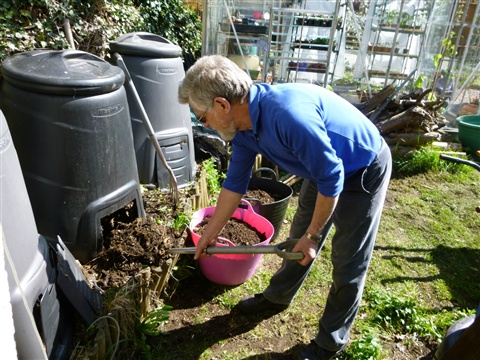
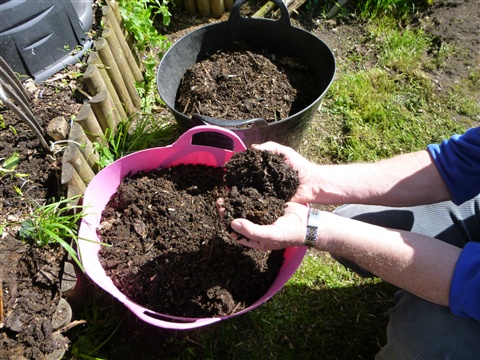

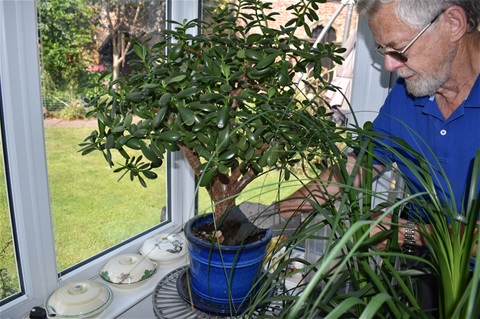
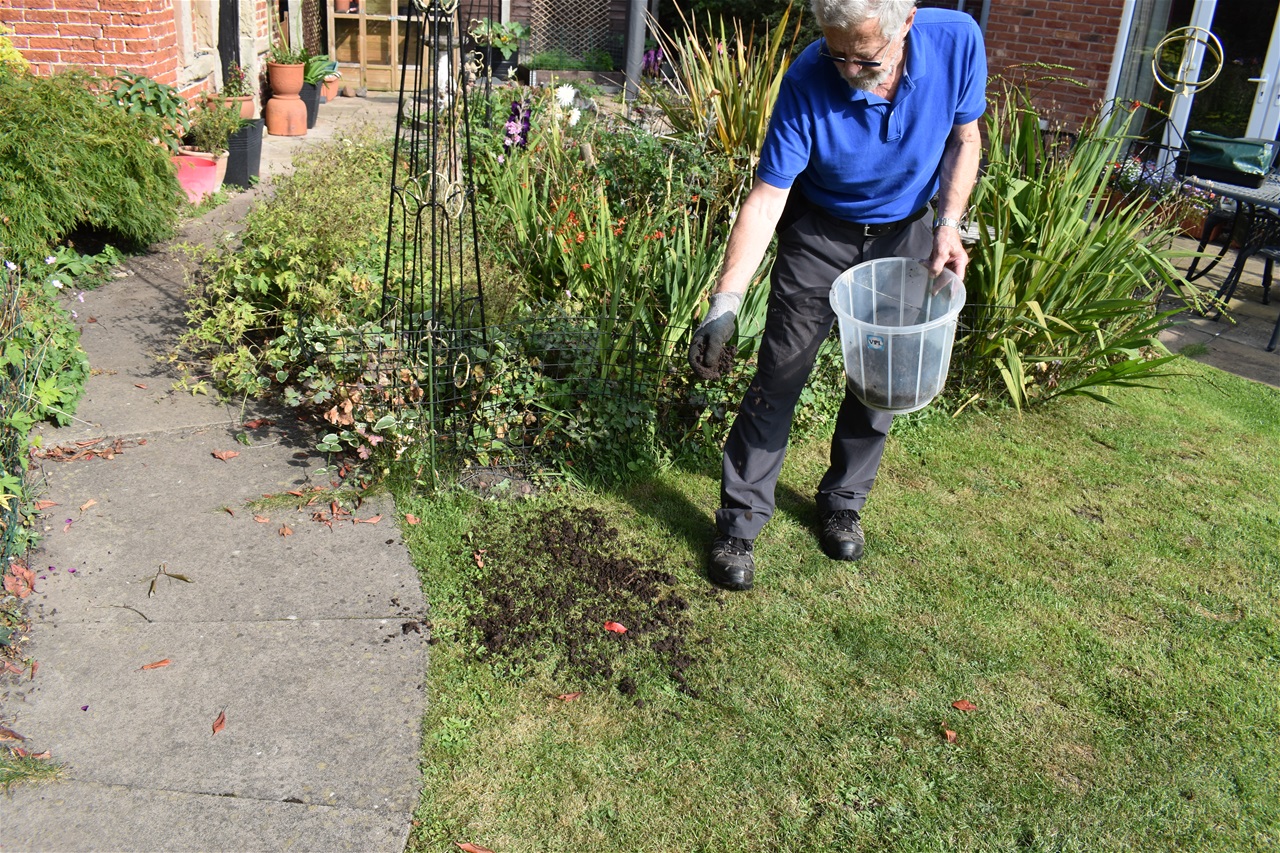

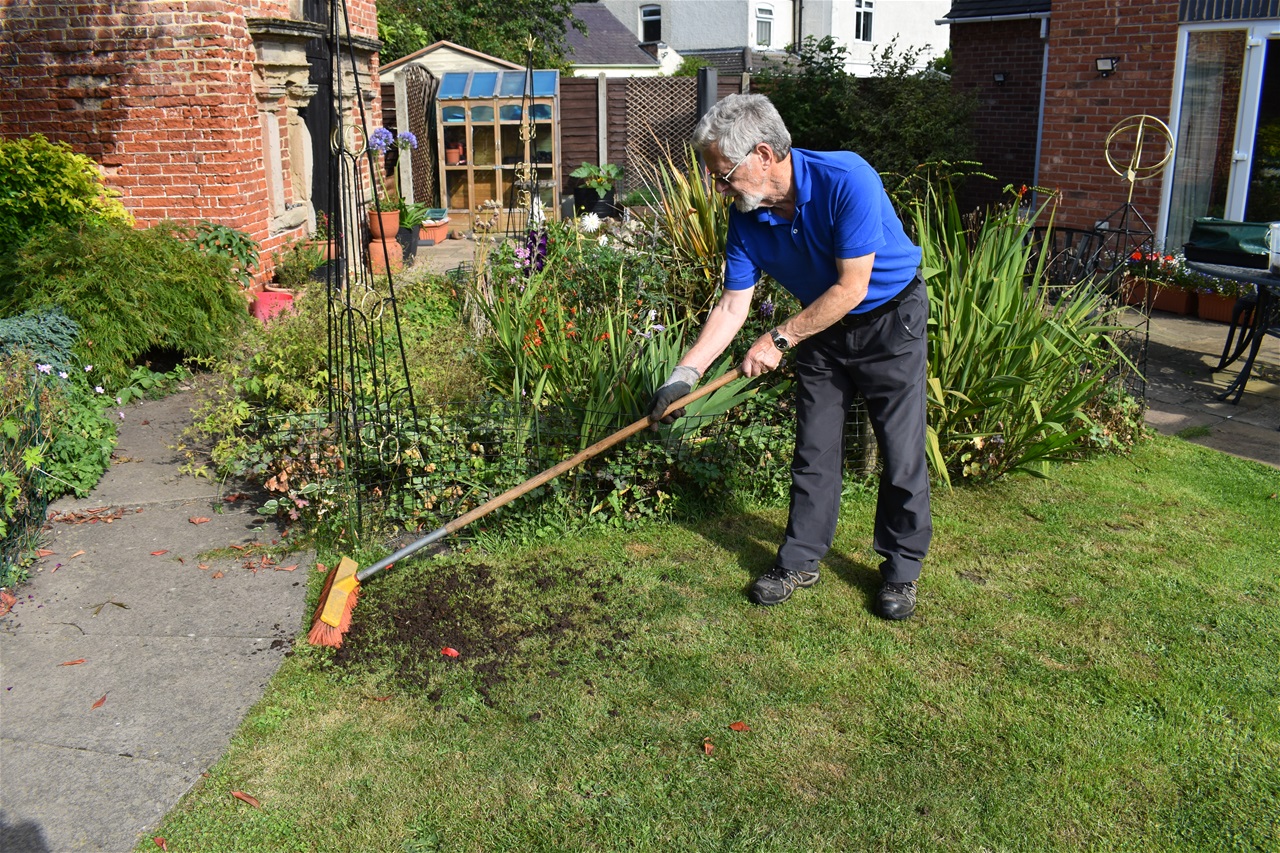
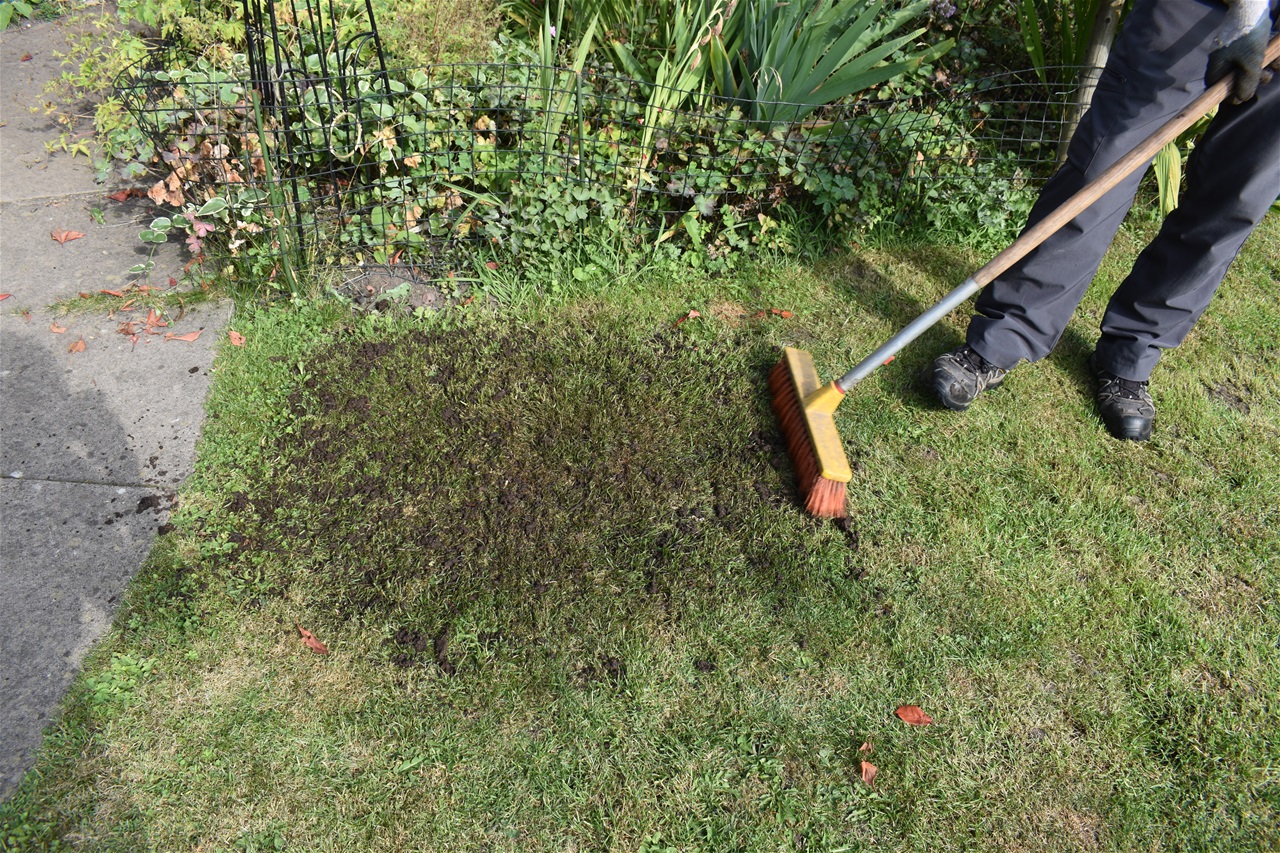
Latest comments
Do you have any data on ' application ' of Aerated Vermi Compost Tea to Mangoes and benneficial outcomes .
Very informative site. Having been away for 5 weeks and returning to evidence of rats under and around the compost bin, I can testify to lack of human activity allowing the rats to get comfortable.
can i use dog manure in compost and mulching leaves?
What is the C and N ratio for coffee chaff?